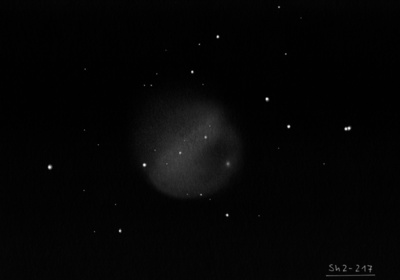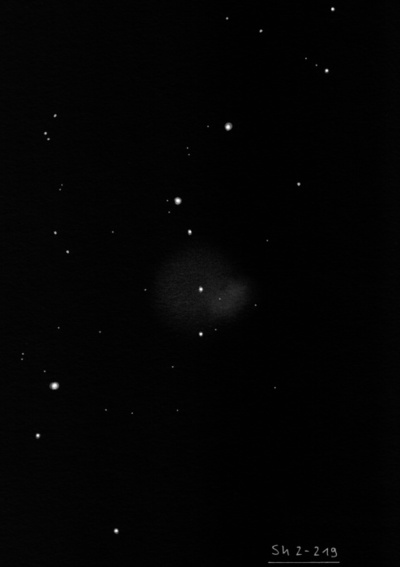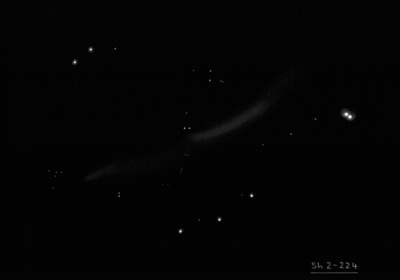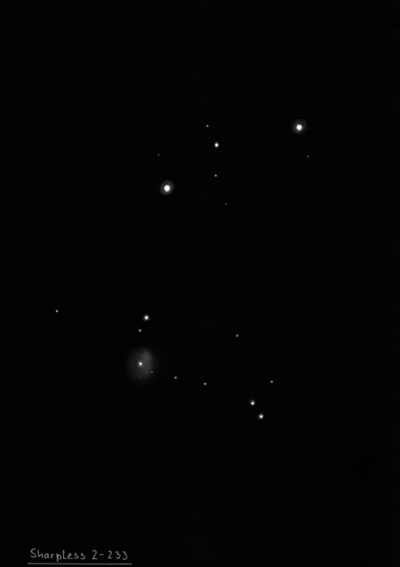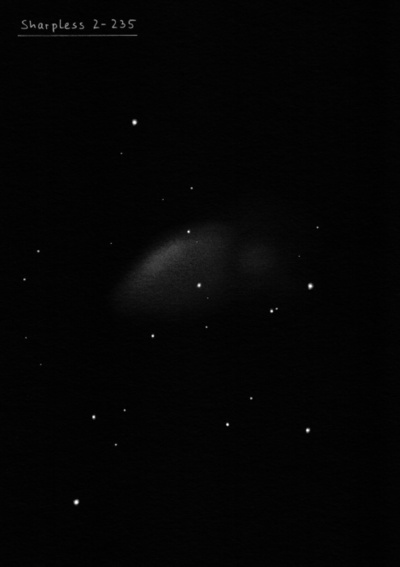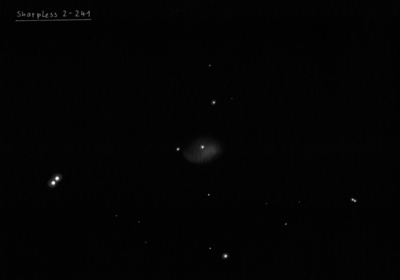The prominent constellation of the northern sky occupies an interesting portion of the winter Milky Way. Bright stars form a distinctive pattern resembling a horseshoe between the constellations of Gemini and Perseus. Its northern part is circumpolar in our latitudes, with the entire constellation not setting below the northern horizon until 60 degrees north latitude. The constellation of Auriga, the Charioteer, is easily located thanks to the bright star Capella, accompanied slightly to the south by three stars: ε, ζ, and η Aurigae, known as the Kids (Haedus). They form a small triangle of stars, easily visible. It is precisely at this point that the Milky Way regains brightness and continues beside the "Staircase" (a notable line of closely spaced stars of 5th magnitude: 16, 17, 18, 19, and IQ Aurigae) in the form of an interesting narrow band towards the south. Within the distinctive horseshoe pattern formed by the five brightest stars of the constellation hides the so-called "Great Trio in Auriga" – the trio of Messier star clusters M36, M37, and M38. These clusters can all be visible without a telescope under excellent conditions.
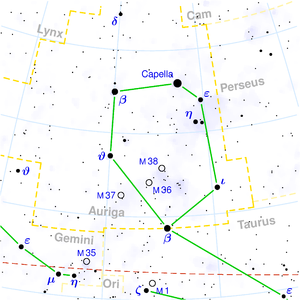
Capella (α Aur) - The brightest star of the constellation and the sixth brightest star in the sky (0.1mag). It never sets in our location. It is the northernmost star in the Winter Hexagon of bright stars. We can easily spot its yellow hue with the naked eye. It is located 43 light-years away and its actual luminosity is 160 times greater than that of the Sun. It is one of the most well-known spectroscopic binary stars, orbiting around a common center, with a period of 108 days. In terms of spectrum and surface temperature, they are comparable to our Sun. The mass reaches 2.5 times, respectively, the mass of the Sun, with one star being 78 times and the other 72 times brighter than the Sun.
θ Aur - The triple star system, with components of brightness 2.6mag and 7.1mag, is separated by 3.6". In the field of view, there is also a third star at a separation of 45". To resolve the entire system, we need a telescope with an 8 cm diameter objective.
Al Anz (ε Aur) - One of the three stars of the Goat, which belongs to the remarkable eclipsing variable stars of the Algol type. It consists of a bright white giant, 37,000 times more luminous than the Sun, and a dark companion, which is not visually observable. Both stars are in mutual orbit. Every 27 years - 9,883 days - the dark component passes in front of the giant and obscures a large part of its light, causing the star ε Aur to significantly darken in the sky - from 3.1 magnitude to 3.8 magnitude. This dimming lasts for several months - about 190 days, then the star remains at a minimum for about half a year, and in the next 190 days it grows from the minimum to the maximum. This suggests that the companion must be surrounded by a dark cloud of gas and dust. The last such eclipse occurred in 2009. Among the known eclipsing variables, it exhibits one of the longest periods.
Sadatoni (ζ Aur) - The next eclipsing variable star from the constellation of the Kids, with a magnitude change from 3.9mag to 4.2mag in a period of 2.66 years - 972.18 days, with the second longest known period. The brightness decrease from maximum to minimum, or the increase from minimum to maximum, lasts only a few days, and the star remains at minimum for 38 days. The main component is red, the secondary component is blue. Sometimes, faint blue stars come to us through the outer layers of a red giant, creating interesting spectroscopic phenomena.
14 Aur - The asterism, main, bright yellow component with a magnitude of 5.2mag is located at a separation of 14.6 arcseconds from a pale blue companion with a magnitude of 7.4mag. In a larger telescope, a third, fainter companion located in a sparse star field is also visible.
26 Aur - triple star, the AB pair (6mag) is too close together to be resolved (0.2") by amateur telescopes, but the third component (8mag) creates a nice contrast with it, consisting of unequally bright yellow and blue stars at a separation of 12.4".
41 Aur - A nice pair of white (6.3mag) and pale blue (7mag) components separated by 7.7" is distinguishable in a small telescope. The surroundings are complemented by the variable star 46 Aur, located 3 degrees to the ENE, which is distinctly orange.
UV Aur - Variable star, which changes its brightness between 7.4mag and 10.6mag over a period of 394.4 days. At a separation of 3.4", there is a companion of 11.5mag. It is a beautiful example of a combination of orange and blue components.
M 37
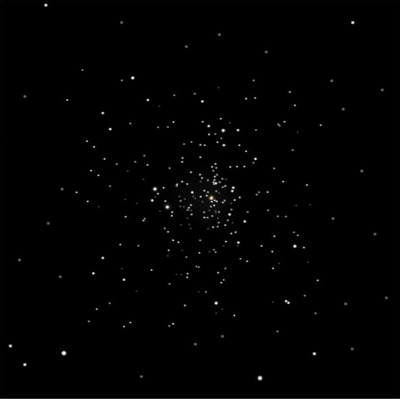
Giovanni Hodierna discovered M37 = NGC 2099 = h369 in 1654. Charles Messier independently discovered the cluster on 2 Sept 1764 and reported a "cluster of small stars, not far from the preceding [M36], on the parallel of Chi Aurigae; the stars are very small, very crowded and containing nebulosity; it is difficult to see the stars with an ordinary telescope of 3 feet and a half." On 4 Nov 1782, William Herschel recorded "Is an astonishing number of small stars with 227; they are almost all of the 2nd or 3rd class. I see no kind of nebulosity in the spot. With 460 the whole is resolvable into stars without nebulosity."
200/250mm - 8" very large, very rich cluster, over 150 stars, rich in mag 10-13 stars. A reddish star, HD 39183, is near the center. Best of the three bright Messier open clusters in Auriga and one of the top open clusters in the sky.
Notes by Steve Gottlieb
M 36
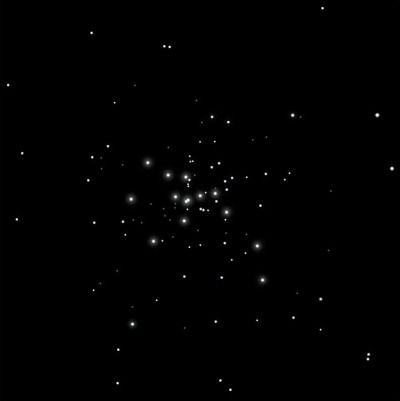
Giovanni Hodierna probably discovered M36 = NGC 1960 = h358 in 1654. Guillaume Le Gentil rediscovered the cluster in 1749 and he is credited with the discovery in the NGC. William Herschel, using his 7-ft reflector (6.2" aperture) at 120x on 28 Oct 1794, called it "a pretty rich cluster of small [faint] stars, seems to have many more than are visible, very small [faint]."
200/250mm - 8" very bright, large, loose, includes two curving star lanes. The double star ?737 = 8.5/9.0 at 11" is near the center.
400/500mm - 18" (1/17/09): at 175x roughly 175 stars are resolved in the central 10' but irregular extensions increase the halo to closer to 20' and includes roughly 250 stars. Many of the stars are arranged in long curving strings as well as one very distinctive curving loop on the SE side of the core with a pretty double (?737 = 8.5/9.0 at 11") with a fainter third companion at the NW end of the loop. The cluster itself is pretty symmetrical with a dense 10' core and the brighter stars are sprinkled about fairly uniformly.
Naked-eye - (10/24/11): just glimpsed in very dark skies.
Notes by Steve Gottlieb
M 38
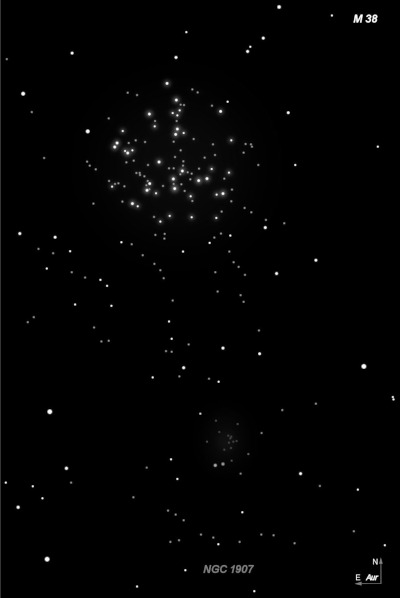
Giovanni Hodierna discovered M38 = NGC 1912 before 1654. It was independently discovered by Le Gentil in 1749 and probably by Messier on 25 Sep 1764 (Le Gentil is not mentioned in his description). WH observed the cluster on 23 Nov 1805 with the large 10-foot reflector and recorded "A cluster of scattered, pretty large [bright] stars of various magnitudes, of an irregular figure. It is in the Milky Way."
200/250mm - 8" large, bright, rich cluster with many 10th magnitude stars, square or cruciform shape, includes a number of double stars. A number of stars are arranged in strings.
400/500mm - 18" (1/17/09): at 175x this gorgeous cluster extends 25'-30' in diameter and contains roughly 200 stars in many irregular groupings. A very pretty string of stars extends N-S out the north side. Includes a very large number of mag 10-12 stars (fairly uniform) with many of the stars group very irregularly in long chains and loops. Some of these chains outline the periphery of nearly starless voids including the unconcentrated center which contains starless patches. NGC 1907 is located 33' SSW, though the two clusters were likely born in different parts of the galaxy.
Naked-eye - (10/24/11): just glimpsed in very dark skies.
Notes by Steve Gottlieb
IC 410
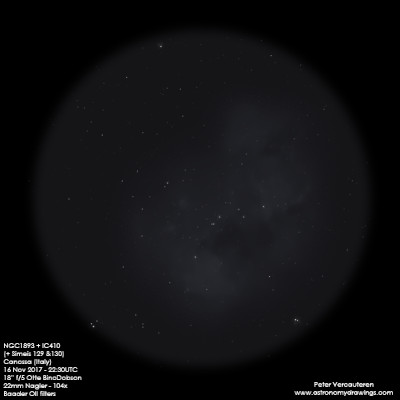
Max Wolf discovered IC 410 on 25 Sep 1892 on a Heidelberg plate. In AN 3130, p159, he noted the plate revealed a group of stars and a large nebula surrounding the star BD +33°1023. His position matches the brightest star (mag 9.0 HD 242908) in the nebula. NGC 1893 refers only to the open cluster, which was discovered by John Herschel.
300/350mm - 13.1" (1/18/85): very faint nebulosity involved with open cluster NGC 1893. The brightest portion is at the NW edge of cluster. A dark "hole" is just south of this nebulosity. More extensive nebulosity is suspected but difficult to confirm due to the general background haze of the cluster. Enhanced with UHC and OIII filters.
13.1" (2/25/84): nebulosity is evident preceding the NW star of the triangle of stars surrounding the cluster. Very faint but definite with a filter in poor transparency.
600/800mm - 24" (1/4/14): at 125x unfiltered; emission nebulosity was evident surrounding and beyond the borders of open cluster NGC 1893, but only a large patch to the northwest of the cluster stood out well. A UHC filter transformed the nebula to a showpiece and it appeared bright, very large (~30' diameter), very irregular with a large darker patch to the west of the central portion of the cluster. The brightest section of nebulosity was to the NW of the cluster (as noticed without a filter), though mag 9.0 HD 242908 (a hot 04-type star) at the NW tip of the cluster is at the east edge of this bright, 6' circular patch. Somewhat fainter nebulosity enveloped the entire cluster but an extensive field of nebulosity continued south of the cluster for an additional 10'. It was difficult to see a clean edge on the south and west side as the nebulosity seemed to gradually fade away, but the entire diameter was at least 25'.
The cometary "Tadpoles" nebulae Simeis 130 and 129, which contain recently minted stars, lie on the east end of the cluster. The "head" of Simeis 130 was immediately picked up at 200x as a very small, fairly high surface brightness knot with at least one star involved. At 260x and 375, two very close "stars" oriented WSW-ENE were embedded in the glow, with the ENE object quasi-stellar (would not focus to a sharp point) and perhaps a very tight pair. Although impressive on images, there was no sign of the wavy tail extending from the "head" towards the NE. Mag 9.1 BD+33 1028, 3' E of Simeis 130, along with a 6' group of a half-dozen mag 10-11 stars, were visually detached to the NE of the main cluster.
Notes by Steve Gottlieb
NGC 1893
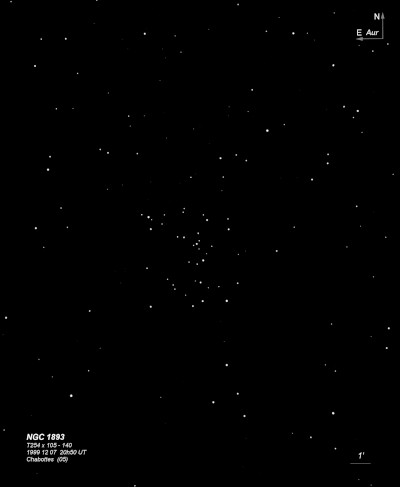
John Herschel discovered NGC 1893 = h351 on 22 Jan 1827 (sweep 51) and described a "rich coarse cluster of scattered stars 9...15m; more than fills field." There is nothing at his position but exactly 3 tmin of RA west is a cluster embedded in the HII region IC 410. JH didn't mention any nebulosity in his description, so the number should just apply to the cluster only, with IC 410 referring to the nebula. The error in position was copied by JH into the GC and by Dreyer into the NGC. In the 1926 photographic survey "Die Herschel-Nebel", Karl Reinmuth gave an corrected RA (noting it with an asterisk).
300/350mm - 13.1" (2/25/84): about 40 mostly faint stars, elongated N-S in poor transparency. Located within a triangle of three mag 8 stars. The emission nebula IC 410 is involved.
600/800mm - 24" (1/4/14): at 200x, this bright, young cluster contains 80-100 stars, with the richest portion forming a large boomerang-shaped region extending 12'x5' N-S. The outline is slightly concave to the west and convex to the east with a narrow denser region in the center with several pairs and trios. NGC 1893 is the core of the Aur OB2 association and contains a number of massive O-type stars including 9th mag O4-type HD 242908 at the NW tip of the "boomerang" and 9.4-mag HD 24296 (O6-type star) forming the SW tip of the outline. In the rich central region is 9.8-mag O7-type HD 242935, and the brightest component of the multiple star Bu 887, with two fainter companions at ~10" separation. Just 1.4' NNW of this triple is a 14" of mag 10.4/11.4 stars, with brighter component BD+33 1025, an O8-type star. Also 2.4' SE is a 10" pair of mag 11.4/12.4 stars. In addition, many other stars appear to be arranged in pairs and strings, so the cluster has a striking appearance. These and other hot O and B-type stars in the cluster ionize the large emission nebula IC 410, which is quite impressive using a UHC filter (see separate description).
The cometary "Tadpoles" nebulae Simeis 130 and 129, which contain recently minted stars, lie on the east end of the cluster. The "head" of Simeis 130 was immediately picked up at 200x as a very small, fairly high surface brightness knot with at least one star involved. At 260x and 375, two very close "stars" oriented WSW-ENE were embedded in the glow, with the ENE object quasi-stellar (would not focus to a sharp point) and perhaps a very tight pair. Although impressive on images, there was no sign of the wavy tail extending from the "head" towards the NE. Mag 9.1 BD+33 1028, 3' E of Simeis 130, along with a 6' group of a half-dozen mag 10-11 stars, were visually detached to the NE of the main cluster.
900/1200mm - 48" (10/27/19): just west of the cluster was a noticeable dark nebula, ~3' in diameter and it provided a striking contrast with the rich cluster immediately to its east and northeast.
Notes by Steve Gottlieb
IC 405
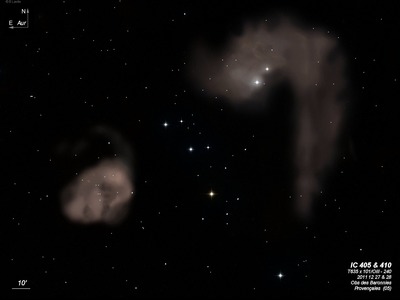
John Martin Schäeberle discovered IC 405 photographically on 21 Mar 1892 using the Willard lens strapped to the 6-inch Clark refractor at Lick Observatory. An announcement ("A Large New Nebula in Auriga") and description was given in PASP, Vol 4, No. 22. Max Wolf also photographed it on 25 Sep 1892 (AN 131 [3130], 159) and in 1903 reported this nebula "looks like a burning body from which several enormous curved flames seem to break out like gigantic prominences". He urged his colleagues to aim their spectroscopes at this "flaming star" - hence the name "Flaming Star Nebula".
300/350mm - 13.1" (12/7/85): very low surface brightness haze at 62x using an H-beta filter, though nebulosity seen to 15' diameter and extending generally to the north and northeast of AE Aurigae.
13.1" (1/18/85): nebulosity highly suspected on east side of AE Aurigae.
400/500mm - 17.5" (2/8/86): the "Flaming Star" nebula is a very faint, large, diffuse nebulosity extending mainly north of AE Aurigae without filter. Enhanced with an H-beta filter.
Notes by Steve Gottlieb
NGC 1931
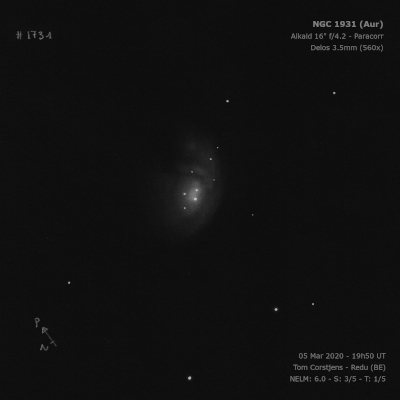
William Herschel discovered NGC 1931 = H I-261 = h355 on 4 Feb 1793 (sweep 1030) and recorded "vB, irr R, vgbM, about 4 or 5' diameter. Seems to have 1 or 2 stars in the middle or an irregular nucleus; the chevelure diminishes very gradually." On 5 Jan 1827 (sweep 42), John Herschel reported "a triple star in a nebula. A most curious object. The nebula surrounds the stars like an atmosphere."
The observers using Lord Rosse's 72" reported 5 to 6 stars were involved on various nights. The first observation was made by Johnstone Stonney on 29 Nov 1848, though he only noted "saw a multitude of stars and some unresolved nebulositiy."
200/250mm - 8" (11/8/80): compact, striking nebulosity involving several stars.
300/350mm - 13" (11/5/83): five stars involved including three close fairly bright stars. A fourth very faint star to the west, fifth very faint star NE and sixth extremely faint star west. This is a bright, high surface brightness nebulosity.
400/500mm - 17.5" (2/8/86): five stars including ADS 4112 (mag 11.5/12.3/13 at 8" and 10") are located within a bright, small nebulosity of high surface brightness. A sixth very faint star is just outside the nebula. Dims with OIII filter.
Notes by Steve Gottlieb
NGC 2281
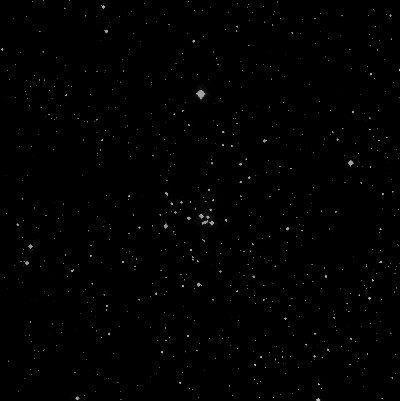
William Herschel discovered NGC 2281 = H VIII-71 on 4 Mar 1788 (sweep 813) and recorded "a cluster of coarsely scattered pretty large stars, pretty rich, the place is that of a double star of the third class." His RA is 1.0 minute too large. The position carried forward to the GC and NGC and modern catalogues including the Lynga Open Clusters Catalog (5th edition) and the RNGC.
By analyzing William Herschel's early "reviews" of bright stars that resulted in the discovery of many double stars, Wolfgang Steinicke recently found (email Oct '16) that Herschel first discovered the cluster on 6 Nov 1782 using his 6.2" reflector.
300/350mm - 13.1" ~40 stars mag 7-13 in cluster, bright, loose. Five double stars are visible including a mag 9.5-11.0 pair at 11" and a mag 11.0-11.5 pair at 15".
400/500mm - 18" (3/13/04): ~75 stars in a 30' region to the south of mag 7.3 HD 49009. A number of stars are arranged in a looping chain. There is a neat kite-shaped group of 6 stars (including two pairs at 10" and 15") in the middle of the chain with a faint star in the center. Scattered stars extend to the south, beyond the kite. The group is fairly bright and distinctive and includes a number of mag 9-10 stars, although there are no dense subgroups.
Notes by Steve Gottlieb
NGC 1857
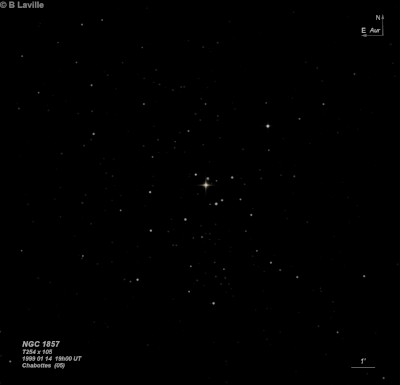
William Herschel discovered NGC 1857 = H VII-33 = h350 on 18 Sep 1786 (sweep 619). He described "a cluster of pretty compressed pS stars, considerably rich, contains one large star, the rest are all of a size." His position is accurate. On 3 Feb 1832 (sweep 399), John Herschel recorded, "a *7m, very ruddy, almost orange-coloured, in a p rich cl of very small stars." Wolfgang Steinicke reports that WH discovered it earlier on 30 Sep 1780 (before his sweeps started), while surveying the brighter stars with his 6.2-inch reflector.
300/350mm - 13.1" (1/18/85): 50-60 stars resolved surrounding mag 7.5 SAO 57903 near the center. This is a very pleasing cluster and is rich in faint mag 13/14 stars.
Notes by Steve Gottlieb
NGC 1664
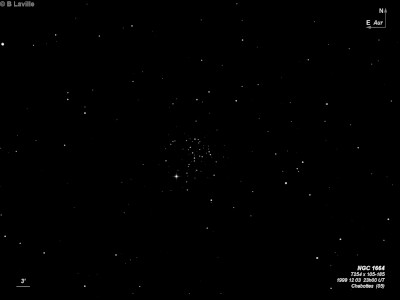
William Herschel discovered NGC 1664 = H VIII-59 on 24 Oct 1786 (sweep 622) and called it "a cluster of coarsely scattered pretty large stars, not very rich." His position was pretty accurate.
300/350mm - 13.1" (1/18/85): 40-45 stars, striking, rich, many faint double stars and chains. A long string of stars to the south leads to mag 7.5 SAO 39807 on the SE edge. Appears rich in the center.
Notes by Steve Gottlieb
NGC 1778
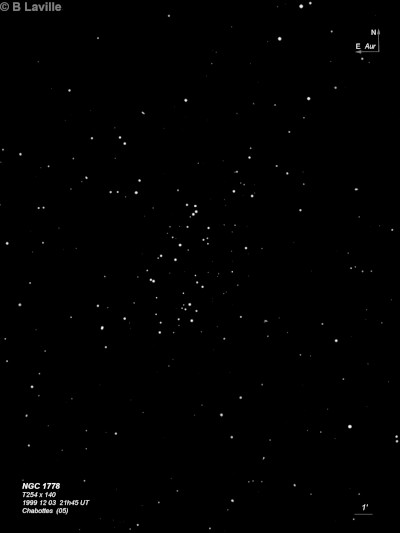
William Herschel discovered NGC 1778 = H VIII-61 = h344 on 17 Jan 1787 (sweep 693) and noted "a coarsely scattered cluster of large stars, irr F, not rich, like a forming one." His position is off the SW side of the cluster. On 3 Feb 1832 (sweep 399), John Herschel described "a double star in a pretty close cluster of 20 or 30 stars." His position was 20' too far north, but he corrected the NPD in a short errata list at the end of his Slough catalogue and the GC has the correct position.
200/250mm - 8" 20 stars mag 10 and fainter in a 6' field, small, elongated NW-SE, nice double star 10/10. Includes a string of mag 10-11 star to the north.
400/500mm - 17.5" (2/1/92): about 50 stars mag 10-15 in a 15' field. Most stars are arranged in two rows oriented NW-SE with a dark lane between. Fairly scattered overall, includes several double stars. There is a nice double star 10/10 at 15" with two mag 13 stars near and 4' SE is a close striking double star h3266 = 9.9/11.1 at 8". A fairly rich clump is at the SE end of cluster.
Notes by Steve Gottlieb
NGC 1907
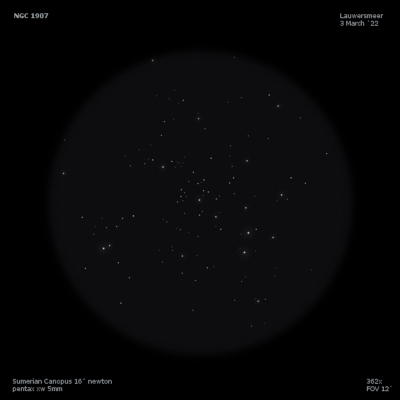
William Herschel discovered NGC 1907 = H VII-39 = h354 on 17 Jan 1787 (sweep 693) and noted "a pretty compressed cluster of small stars, near 4' diameter." John Herschel made three observations and reported on 5 Jan 1827 (42), "p Rich; irreg R; stars 9...12m, 50 or 60 counted; bM."
200/250mm - 8" (11/5/83): rich, glowing cluster, compact, includes two bright stars to the south.
300/350mm - 13.1" (11/5/83): dense, about three dozen stars.
400/500mm - 17.5" (10/12/85): 50 stars in a 7' diameter. Includes a few bright stars but very rich in fainter stars in the central region. A wide pair of mag 9.5-10 stars is at the south end (9.6/9.9 at 52") and a closer pair is off the NE side (h699 = 10.4/11.6 at 10"). Located 33' SSW of M38.
Notes by Steve Gottlieb
NGC 2126
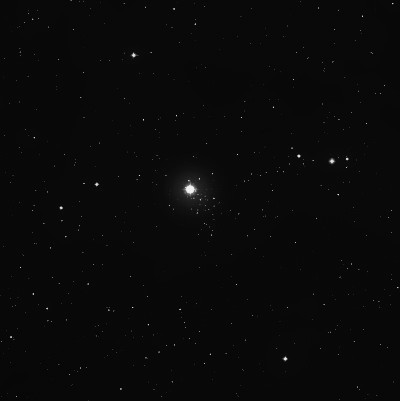
William Herschel discovered NGC 2126 = H VIII-68 on 12 Nov 1787 (sweep 781) and recorded "a small cluster of scattered stars, not rich, one 7th mag towards the northern side, but it does not seem to be connected with the cluster." His position is very close to mag 6 HD 40626, although this is at the northeast side of the cluster and is probably not related.
Ling notes that position of this cluster should be 06h 02.6m +49d 52' according to Megastar position.
200/250mm - 8" (1/1/84): 20 stars mag 12-13.5. Located close SW of a mag 6 star, appears rich with averted vision.
300/350mm - 13.1" (2/25/84): 25-30 stars mag 12-14.5, fairly dense, small, pretty cluster. The cluster is dominated by mag 6.1 SAO 40801 which lies on the NE side of the cluster.
Notes by Steve Gottlieb
IC 2149
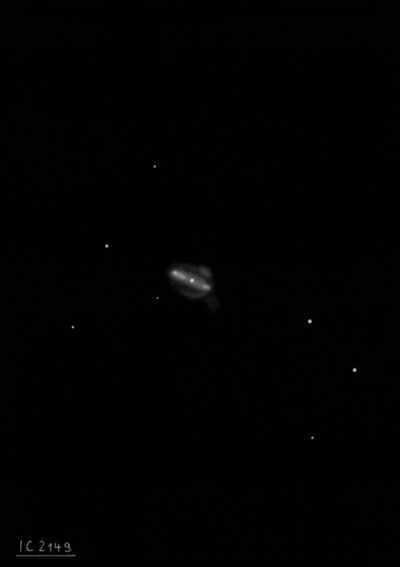
Williamina Fleming discovered IC 2149 = HN 105 in 1906 on a Harvard objective prism plate.
Based on Crossley photographs, Curtis (1918) reported IC 2149 as, "nucleus slightly elongated and about mag 12, but actual central star may be fainter. Central portion an oval of very bright matter with two fainter ansae showing indistinct traces of ring structure; this 12"x6" in pa 75°. Still fainter matters forms an irregular oblong outside of this, 15"x10", and on the eastern end a very faint cone-shaped ansa extends 5" farther."
200/250mm - 8" (12/79): appears as a fuzzy blue "star at 100x. Very small and slightly elongated SW-NE at 222x.
400/500mm - 17.5" (9/14/85): at 250x the bright central star is easily visible within a bright, small, high surface brightness oval elongated 3:2 ~E-W. Located 38' NW of mag 4.2 π Aur.
17.5" (1/31/87): similar view as last observation but I noticed a slight bluish color.
Notes by Steve Gottlieb
NGC 2192
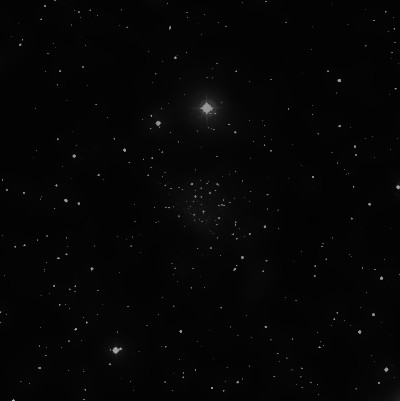
William Herschel discovered NGC 2192 = H VII-57 on 31 Dec 1788 (sweep 901) and recorded "a compressed cluster of vS stars, irregular figure, 6' diameter, considerably rich." His position (Auwer's reduction) is accurate. This older cluster has an age of roughly 2 billion years
300/350mm - 13.1" (12/22/84): two dozen very faint stars in a 4' diameter over unresolved haze.
Notes by Steve Gottlieb
IC 417
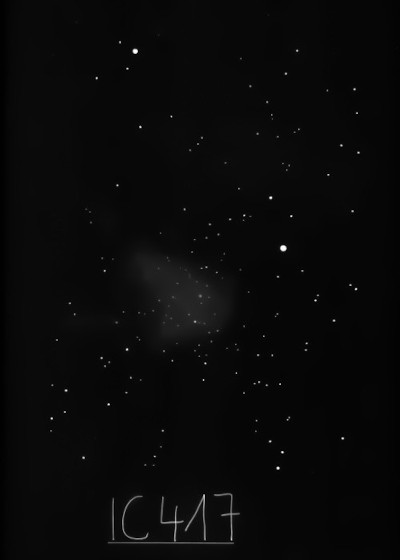
Max Wolf discovered IC 417 on 25 Sep 1892 on a Heidelberg plate. In AN 3130 (131), p159, he noted a "vast nebula envelopes the star cluster" and his position is within the cluster.
200/250mm - 8" (12/6/80): faint nebulosity involved with three stars mag 9-11 including ∑707 = 9.7/11.4 at 18". The brightest portion is located 8' SE of Phi Aurigae (V = 5.1). Embedded in the open cluster Stock 8.
400/500mm - 17.5" (2/9/02): this large HII region encases the open cluster Stock 8 and is situated ~6' SE of 5th magnitude Phi Aurigae. At 140x, the cluster consists of 40-50 stars including two mag 10 (the brightest is the wide double ∑707 = 9.7/11.4 at 18") and numerous mag 12-14 stars. With a UHC filter (or OIII filter at 100x), the cluster is encased in a moderately bright glow, ~8'x5'. The nebulosity is brightest in a triangular wedge, tapering towards the south with the two mag 10 stars oriented N-S (2' separation) along the western boundary. The glow is irregular but has a fairly sharp border along the western edge.
Notes by Steve Gottlieb
NGC 1985
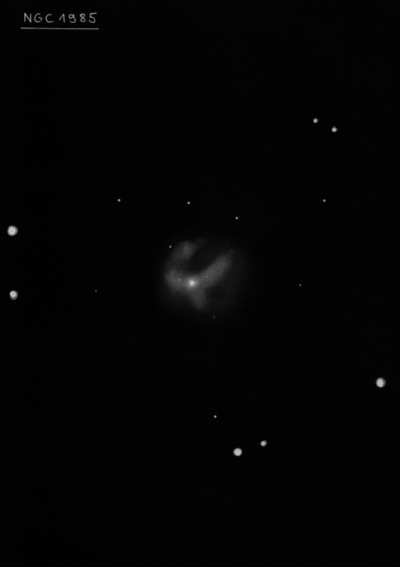
William Herschel discovered NGC 1985 = H III-865 = h359 on 13 Nov 1790 (sweep 980) and recorded "vF, vS, R, bM. 300 showed it very plainly." His position was 2.5' too far NW, though JH measured on accurate position. R.J. Mitchell, observing on 28 Dec 1856 with Lord Rosse's 72", remarked "Looks like a star enveloped in a vF nebulous atmosphere which is lE nearly preceding-following."
This reflection nebula was misclassified as a PN (PK 176+00.1) in Kohoutek's Catalogue of Galactic Planetary Nebulae and the RNGC repeats this error.
300/350mm - 13.1" (1/18/85): faint reflection nebulosity surrounding a mag 13.5 star. This small, circular nebula is visible without a filter.
Notes by Steve Gottlieb
NGC 2242
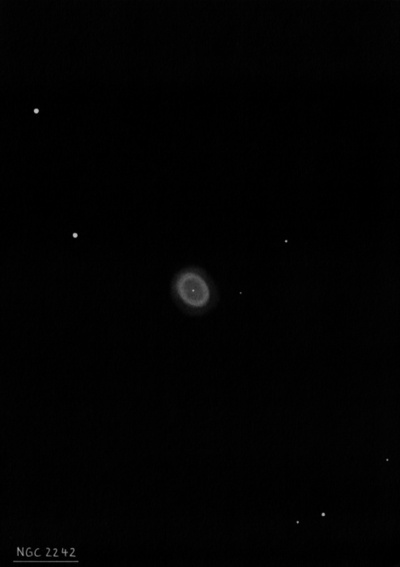
Lewis Swift discovered NGC 2242 = Sw. VI-27 on 24 Nov 1886 with the 16" refractor at Warner Observatory. This is the last planetary nebula, by discovery date, to be included in the NGC. RNGC and CGCG (204-005) misclassify NGC 2242 as a galaxy although the RNGC new description reads "R, HISB, STEL, PLN??", so it questioned if it was perhaps a PN instead.
In 1985, spectroscopic investigations by Richard Shaw and William Bidelman revealed that NGC 2242 is a previously uncatalogued planetary nebula (independently shown to be a planetary by Machara in A&A 178, 221). It was included as a new planetary nebula in Kohoutek's 4th update list (AN 315, 1994). See my RNGC Corrections #2.
400/500mm - 17.5" (1/31/87): faint, small, almost round. Unusually weak filtration response as appears similar brightness or slightly fainter using filters! Estimate V = 14.5. This object was recently discovered to be a planetary in 1985 (Shaw and Bidelman) and is listed in the CGCG.
Notes by Steve Gottlieb
IC 2120
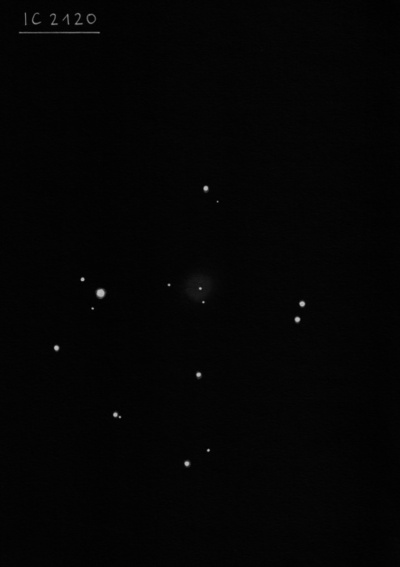
| Type | HII |
| descr | This is a measurement of Comet 113P/Spitaler 1890 mistaken for a nebula. |
| RA | 05:18:10.3 |
| Dec | +37:33:27.0 |
| major_axis | 60.0'' |
| mag | 12.0 |
| surface_bright | 11.7 |
Pal 2
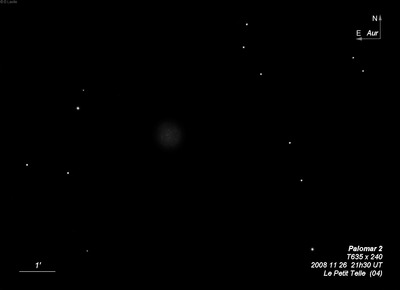
| Type | GC [IX] |
| RA | 04:46:06.0 |
| Dec | +31:23:00.0 |
| major_axis | 2.2' |
| mag | 13.0 |
| surface_bright | 14.5 |
LBN 809
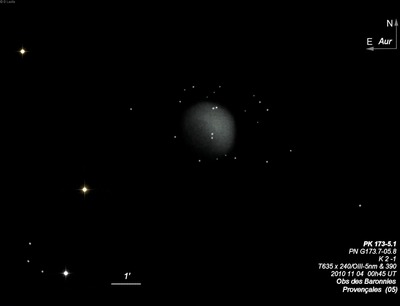
| Type | PN |
| RA | 05:07:09.1 |
| Dec | +30:49:28.0 |
| major_axis | 2.2' |
| mag | 13.7 |
| surface_bright | 15.2 |
Abell 8
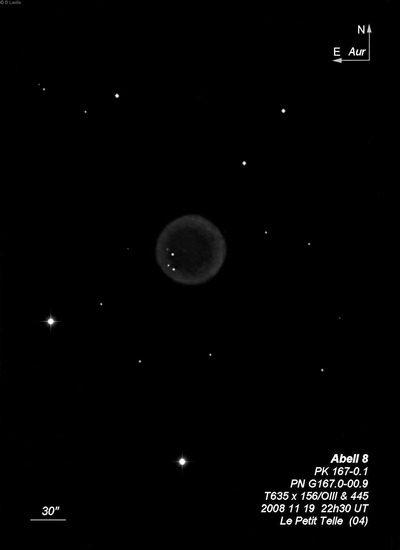
| Type | PN [2b] |
| RA | 05:06:38.4 |
| Dec | +39:08:09.0 |
| major_axis | 60.0'' |
| mag | 16.6 |
| surface_bright | 16.3 |
Abell 9
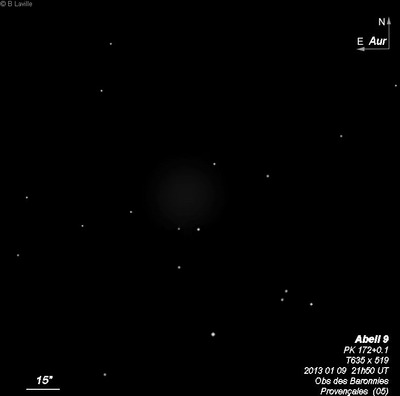
| Type | PN |
| RA | 05:28:56.7 |
| Dec | +36:03:05.0 |
| major_axis | 36.0'' |
| mag | 17.8 |
